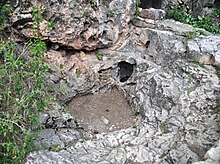
A breathing cave or barometric cave is a rare type of cave in which atmospheric pressure gradients between the inside and outside of a cave cause air to flow in to or out of the cave. The concept of air flowing through a cave is common, however in most caves this airflow is caused by a difference in temperature rather than air pressure; in barometric caves the thermal mechanism inside the cave is not great enough to cause such airflow. The speed of the airflow in barometric caves is directly correlated with the atmospheric pressure difference between the inside and outside of the cave. When the air pressure outside of the cave is higher than that inside the cave air blows into the cave and vice versa; if the air pressures are at equilibrium there is no airflow.
In some breathing caves, the airflow can only be meaningfully measured near the entrance. This tends to be the case in caves which primarily feature large, wide passageways, notably Wind Cave in South Dakota, US, and Lechuguilla Cave in New Mexico, US. In caves which mainly consist of narrow passageways, such as Jewel Cave, also in South Dakota and less than 30 kilometers (19 mi) away from Wind Cave (though the caves are not connected), airflow can be measured in many areas throughout the cave system. The barometric theory of the airflow in Jewel and Wind Caves was first noted by Herb Conn in 1966. Jewel Cave and Wind Cave are the most well-documented examples of breathing caves.
Geology
All known breathing caves are solutional caves, and breathing caves tend to be much longer than most other caves. Four of the ten longest caves in the world are breathing caves (namely Jewel Cave, Wind Cave, Clearwater Cave, and Lechiguilla Cave).
Notable examples
Some examples of breathing caves include:
| This list is incomplete; you can help by adding missing items. (January 2024) |
- Butler Cave, Virginia, United States
- Cave of the Winds, Colorado, United States
- Clearwater Cave, Malaysia
- Jewel Cave, South Dakota, United States
- Lechuguilla Cave, New Mexico, United States
- Peștera Vântului, Romania
- Postojna Cave, Slovenia
- Wind Cave, South Dakota, United States
Further reading
- Pflitsch, Andreas et al. Dynamic climatologic processes of barometric cave systems using the example of Jewel Cave and Wind Cave in South Dakota, US
References
- Gomell, Annika; Austin, Daniel; Ohms, Marc; Pflitsch, Andreas (September 2021). "Air pressure propagation through Wind Cave and Jewel Cave: How do pressure waves travel through barometric caves?". International Journal of Speleology. 50 (3): 263–273. doi:10.5038/1827-806X.50.3.2393 – via University of South Florida.
- "What Causes the Wind of Wind Cave - Wind Cave National Park (U.S. National Park Service)". www.nps.gov. Retrieved 2024-01-08.
- ^ Pflitsch, Andreas; Wiles, Mike; Horrocks, Rodney; Piasecki, Jacek; Ringeis, Julia (March 2010). "Dynamic climatologic processes of barometric cave systems using the example of Jewel Cave and Wind Cave in South Dakota, USA". Acta Carsologica. 39 (3): 449–462. doi:10.3986/ac.v39i3.75 – via ResearchGate.
- "Cave Climates – National Cave and Karst Research Institute". 2021-02-02. Retrieved 2024-01-08.
- ^ "Cave Explorers – Jewel Cave National Monument (U.S. National Park Service)". www.nps.gov. Retrieved 2024-01-08.
- "Esri News – ArcNews Winter 2002/2003 Issue – Developing a Cave Potential Map for South Dakota's Wind Cave Using GIS". www.esri.com. Retrieved 2024-01-08.
- KellerLynn, K. (2009). Jewel Cave National Monument Geologic Resources Inventory Report, National Resource Report NPS/NRPC/GRD/NRR 2009/084. US National Park.
- Conn, Herbert (April 1966). "Barometric Wind in Wind and Jewel Caves, South Dakota" (PDF). Bulletin of the National Speleological Society. 28 (2): 55–69.
- "What is the BCCS?". www.butlercave.org. Retrieved 2024-01-08.
- "Cave of the Winds". Colorado Encyclopedia. 15 June 2016. Retrieved May 31, 2020.
- Lawrence, Ken (2019-02-24). "Mulu National Park: Exploring the Caves". Sailingstone Travel. Retrieved 2024-01-27.
- ^ "Cave Air Dynamics & Geochemistry". Welcome to the Paha Sapa Grotto!. Retrieved 2024-01-08.
- Gabrovšek, Franci (2023-04-03). "How do caves breathe: The airflow patterns in karst underground". PLOS ONE. 18 (4): e0283767. Bibcode:2023PLoSO..1883767G. doi:10.1371/journal.pone.0283767. ISSN 1932-6203. PMC 10069778. PMID 37011070.
| Cave topics | |
|---|---|
| Glossary of caving and speleology | |
| Main topics | |
| Types and formation processes | |
| Speleothems and Speleogens (Cave formations) | |
| Dwellings | |
| Popular culture | |
| Incidents | |
| This article needs additional or more specific categories. Please help out by adding categories to it so that it can be listed with similar articles. (January 2024) |